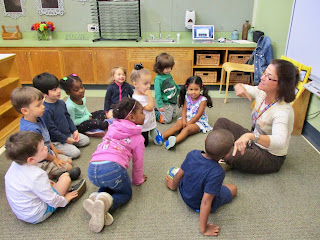Welcome families and friends! Our Spanish Program for the 2017-18
school year got off to a great start! Our most important
objective en la clase de español is
to provide a nurturing environment where everyone feels comfortable learning a
second language and to encourage all to develop an openness, understanding and
appreciation for other cultures. Since the start of the school year, students have enthusiastically expressed their joy in Spanish class as they engage in
playing games, greeting puppets, listening to storybooks, singing, and
role-playing using written dialogues.
As an introduction to the Spanish program
that is new to most of our youngest members, the pre-kindergarten classes have
been enjoying listening and practicing our traditional morning song, Buenos días amigos, buenos días (Good
morning friends, good morning) and the ending of class song, ¡Adios, hasta luego! (Good-bye, until
later). Additionally, to prepare the Cardinals,
Catbirds and Sparrows for the traditional beginning of class activity, ¿Dónde vamos hoy?, the students have
been learning the vocabulary for some basic modes of transportation such as carro (car), tren (train), bote (boat)
and avión (plane). They also got a
tremendous kick out of meeting our beloved, la
vaca (the cow). La vaca loves to
end each class by thanking all the students for participating in Spanish class.
When gently squeeze, la vaca will say
moochas-gracias (thank you
very much) to which we all reply, de nada
(you’re welcome).
In el
Jardín de Infancia (kindergarten) the students have been learning and/or
reviewing los números del cero al veinte (the numbers from
zero to twenty). One fun way has been using el
dado (the die). Each child took a turn at tossing a plastic die with clear
pockets holding a flashcard with a number. Once the die settled, the student
would identify the number, in español,
and lead the class in counting with a movement activity to represent the amount
of the number chosen. Other than helping students enhance the concept of
matching symbol with a sound, this was an excellent way for us all to get our
morning exercise, teacher too, as there were lots of requests for jumping
jacks, push-ups, and even burpees!
To review and reinforce previous year’s
learning, in Primer (1º) Grado the
students have been working with the modes of transportation. To help us, we played the infamous game, ¿Qué falta? (What’s missing?). This is a
game that fosters the students’ memory through concentration and focus. In this
fun activity, miniature props of transportation were placed for all to see.
They were then covered with a bandana and one object was taken away. Once the
kerchief was removed, the students were asked, ¿Que falta. The students raised their hands and when picked, took a
guess at stating in español which
item was missing. The best part was when the students were given a turn at
leading the game. They were very proud to take on the role.
To connect with their birthday month graphing
activity in math class, in Segundo (2º)
Grado the students have been practicing los
meses (the months). After a variety of activities to practice saying the
months, including viewing and listening to a catchy song on You Tube, the
students were invited to an activity that required placing the months in order.
They were asked to break into groups and each set was given the names of los meses in strips with the goal of
placing them in order. This activity is
a fun way to help second graders build on the skill of recognizing the
relationship between a sound and its corresponding written word in español.
In Tercer
(3º) Grado the students joyfully engaged in many activities for practicing saludos (greetings) in español. They had an absolutely fun time
reading a dialogue in Spanish to one another. What made the experience even
more amusing was that they used a títere
(puppet) as they took turns in following the script to greet each other.
And, in Cuarto
(4º) Grado the students have begun conducting research for the well-known
assembly game, ¿Dónde vamos hoy? At the beginning of the school
year, each fourth grader chose a country to research and determine what she or
he feels are the three best possible fun facts. Before each assembly throughout the school year, one
country will be chosen and the fourth grade students will state the clues, in
ingles y español, to the Lower
School community. Then, all are invited
to figure out the mystery Spanish-speaking country by filling out a form and
slipping it in a box located outside the Spanish office, El Palacio. During the following assembly, the name of the country
will be revealed.
We have definitely gotten off to a wonderful
start. I look
forward to the many, many adventures and experiences ahead. Hasta nuestra próxima noticias (until
our next news), ¡Adiós!
Con mucho cariños,
Alicia







No comments:
Post a Comment